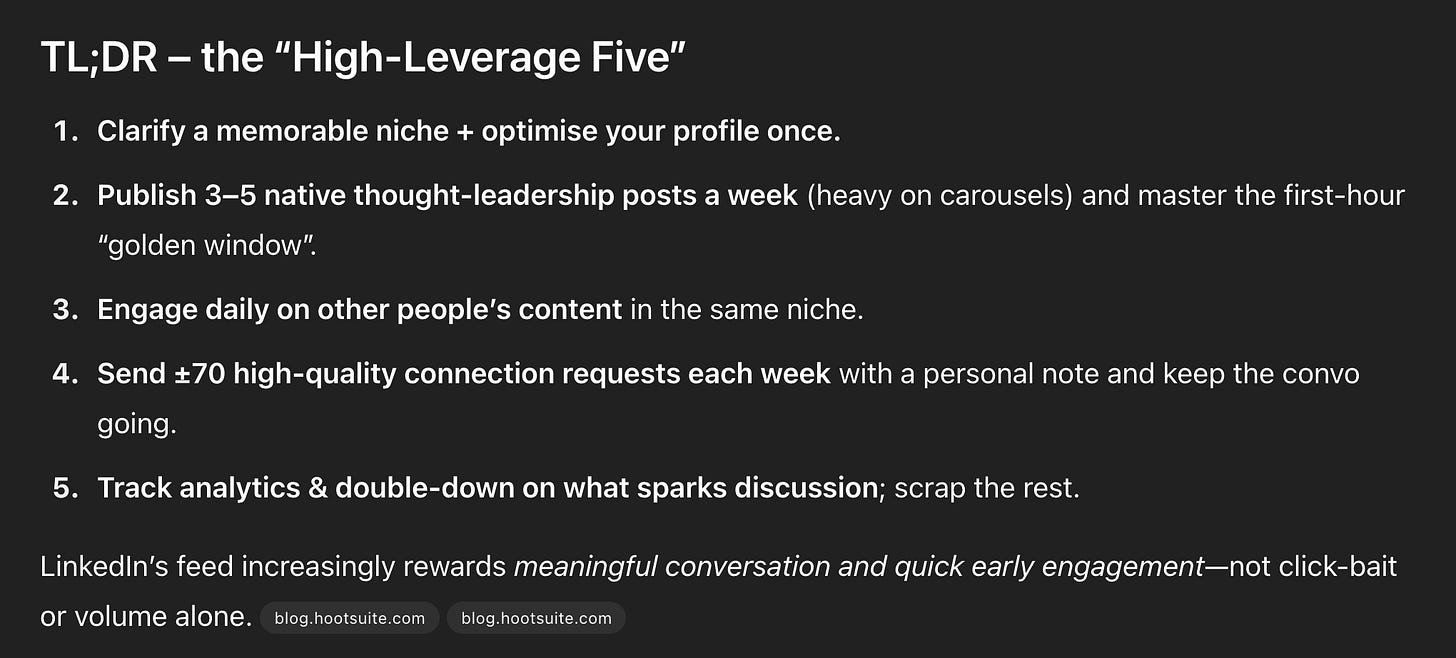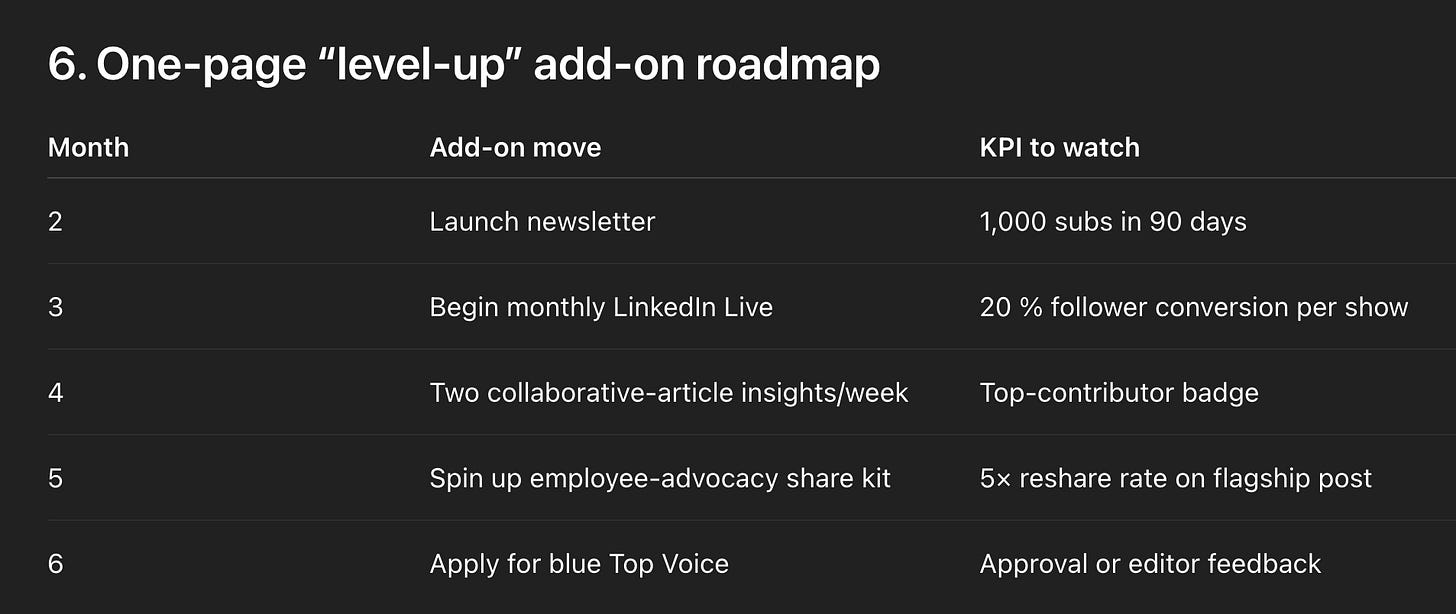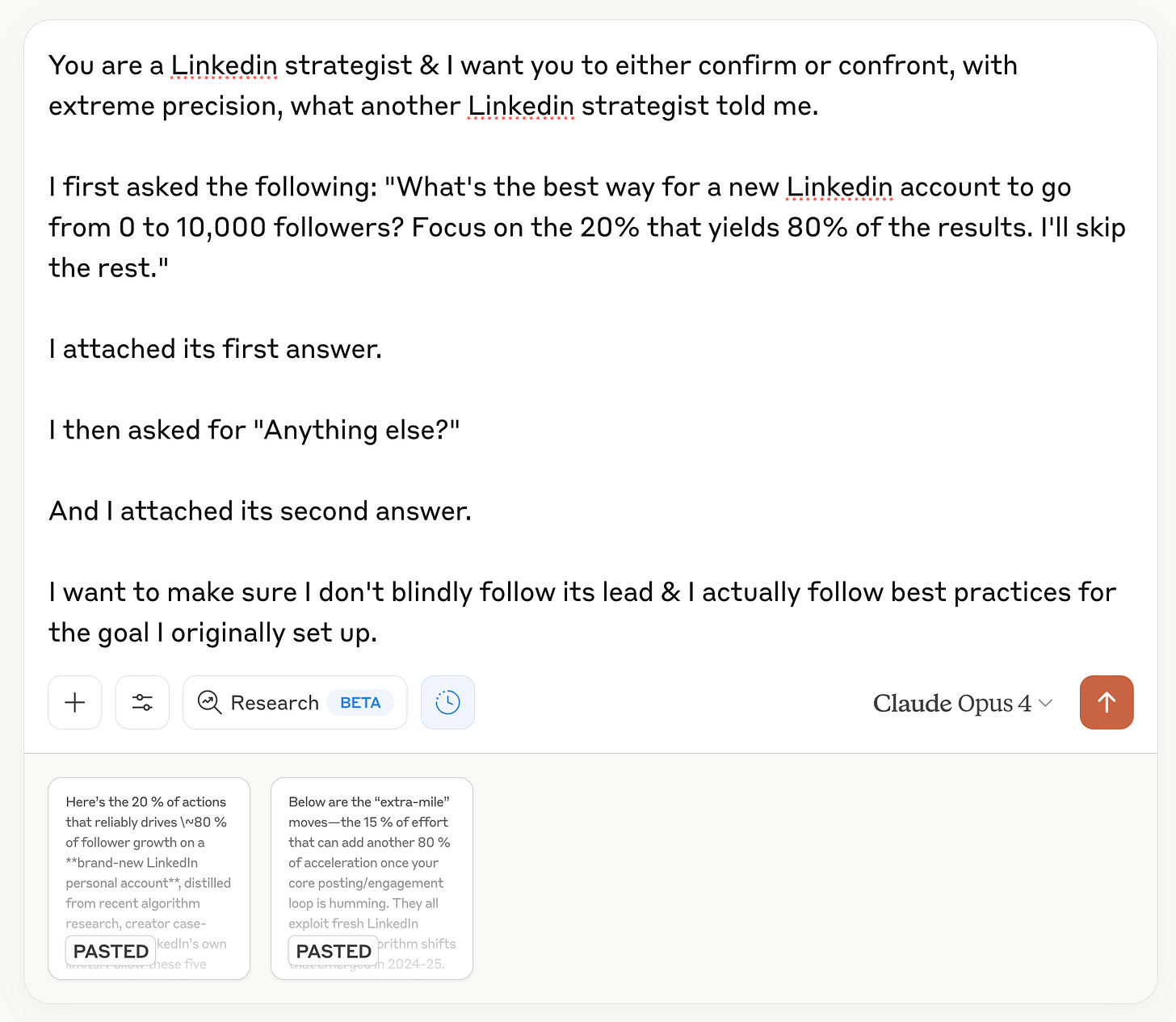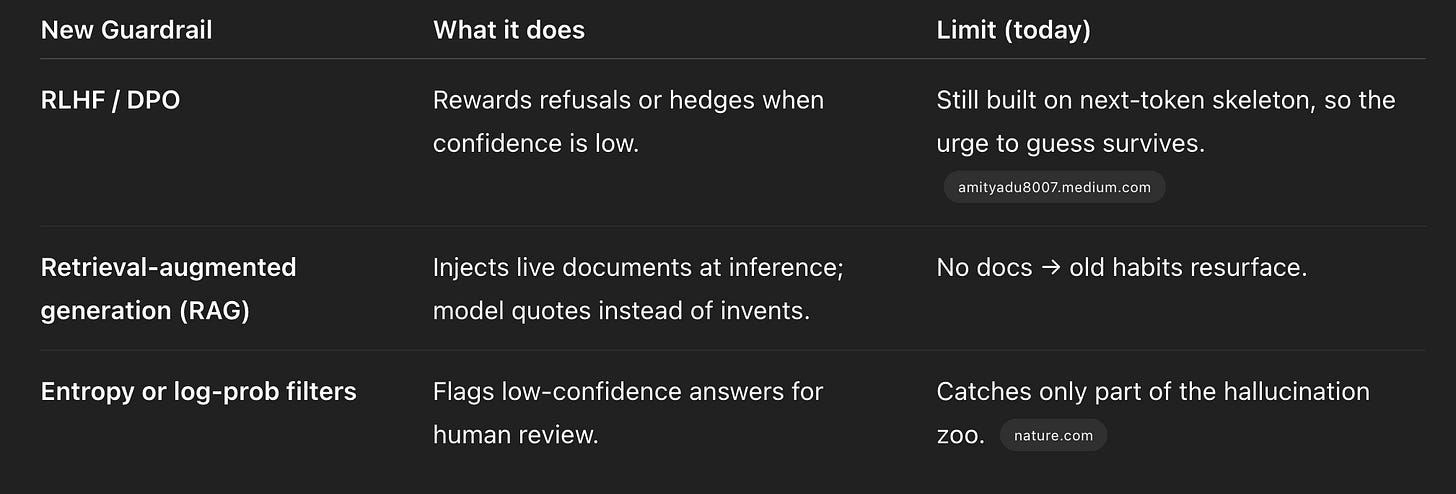How to make AI battle for you.
A step-by-step guide to make ChatGPT & Claude fight for truth.
You and I don’t know what’s best between ChatGPT & Claude.
☑ They both search online.
☑ They both reason (before answering).
☑ They both are smarter than a typical guy.
But us typical guys can both use them to our advantage.
Instead of choosing between the two, I make them battle.
I call it “LLM Battle” (LLM = Large Language Model).
Why do I want to teach you LLM Battle (with examples)?
→ LLMs fall often into confirmation bias. And that’s a problem.
confirmation bias: the tendency to favor information in a way that confirms one's prior beliefs.
Basically, LLMs are often “Yes-men” who never second guess you (or themselves).
And my best cure for confirmation bias? LLM Battles.
LLM Battle is not for:
Quick Google-search like queries.
Simple tasks, or ones with one answer.
LLM Battle is best for:
Long, deep queries that involves internet search.
Complex tasks that can’t fall into confirmation bias.
Let’s get straight to it.
Start with ChatGPT
I always start with ChatGPT.
☑ It has my entire memory of conversations.
☑ I built its internal custom instructions too (more on this next month).
☑ It’s agentic capabilities (= being able to search & reason through the web) are often unmatched.
I do say often, because ChatGPT is pretty big on confirmation bias.
Let’s take an example I know best:
Reminder: you always use o3 + search for this kind of queries.
Optional bonus: using Deep Research instead for a long PDF report.
Here’s ChatGPT’s answer:
Absolutely crazy. Everything is on-point, not only true but precisely what I would have said.
But let’s dig deeper now. I asked ChatGPT for “Anything else?”.
And that’s where things get messy.
ChatGPT tells me to:
Launch a newsletter within Linkedin (you must do it outside).
Going live once a month on Linkedin (don’t, it gives little views).
Two collaborative articles for the badge (it doesn’t exist anymore).
3 extremely bad advice, especially for the first months of your Linkedin growth.
Time to ask my other friend, Claude.
Question ChatGPT with Claude
I simply asked the following to Claude:
I copied the first & second answer from ChatGPT. And when you paste a text “this long”, it creates an attachment on Claude. It’s a nice touch.
Now let’s check Claude’s brillant answer:
☑ Launching a newsletter is too early (I agree).
☑ Be careful with the quality of your comments (you actually must comment with over 12 words - and no, using automated AI bots won’t work).
☑ Top voice badge has been killed for collaborative articles (yep).
LLM Battle is already working. Let’s continue the fight.
Head-to-Head battle
I have a conviction that something is wrong with both their advice: they both promote having a newsletter within Linkedin (when I know for a fact someone shouldn’t).
It’s the perfect battleground for yet another fight. But this time, I simply continue my conversation on both sides, asking the same question:
I agree with ChatGPT’s answer:
Avoid LinkedIn-only dependency; long-term brand equity lives in contact data you personally own.
But Claude disregards it:
LinkedIn newsletter first gives you proof of concept with minimal effort.
This is no longer “Hey Claude, ChatGPT said that, what do you think?”.
This is just double prompting the same problem, on 2 separate conversations.
And when I confront Claude, it now flinches:
It even calls ChatGPT’s approach “brillant”.
The framework to copy
I will try to create an evergreen template for any situation.
Step 1: Ask ChatGPT o3(-pro) + Activate search toggle.
Step 2: Confront ChatGPT’s answer with Claude with this prompt:
Act as [expert].
I want you to either confirm or confront, with extreme precision, what another [expert] told me.
I first asked the following: [original prompt]
I attached its first answer. [copy & paste ChatGPT’s answer]
I want to make sure I don't blindly follow its lead & I actually follow best practices for the goal I originally set up.
Step 3: Make them battle until you reach an agreement.
Bonus: Share the same prompt on both conversations when you have a doubt. Compare the answers. Confront the one you dislike the most with the best answer from the one you prefer.
Why LLMs lie?
People think LLMs “lie,” but they’re judging a calculator for doing what a microscope cannot: it completes language, it doesn’t certify reality.
I was having coffee with a friend last week.
She asked Claude to name “five Paris cafés with 24-hour Wi-Fi.”
Claude cheer-chatted back a list. Three of them never existed.
“See? AI lies,” she sighed.
Wrong diagnosis.
The model didn’t decide to deceive her; it simply kept its contractual promise: predict the next token that looks right.
In the past, we wired LLMs to…
Finish sentences, whatever it takes.
Training = “minimise the next-token loss.” No reward for saying “I don’t know.”Talk even when clueless.
The decoding step (temperature, top-p) forces a guess where silence would be honest.Optimise for fluency, not fidelity.
A model is called better when its prose sounds human—truth isn’t in the metric.
Result? Hallucinations: plausible-looking text that reality never signed off on.
But now we’re teaching them to say, “Maybe.”
Good news: GPT-4 family cuts open-domain hallucinations by ~19 pp vs GPT-3.5.
Bad news: zero-hallucination AI is still science fiction.
One prompt to rule them all
If you don’t have the time to make LLMs battle like I previously showed you, I have another useful prompt to simply copy & paste:
Let’s take a step back in our conversation.
I will use a prompting technique called “Perspective Transitioning” to avoid falling into confirmation bias.
You will enact two completely different experts to fully read our conversation, and critic our discussion, learnings & conclusions. Their critics is based on science, truth, deep search & expertise on the matter.
Step 1: Pick these two completely different experts.
Step 2: Re-read our entire conversation, from the first prompt to the last.
Step 3: Share the first expert point of view.
Step 4: Share the second expert point of view.
Copy this snippet of prompt whenever you feel going in circles with LLMs.
So wait, why do LLMs “lie”?
Because we never asked them to seek truth.
We asked them to keep talking.
So here’s my 30-second playbook vs. hallucinations:
Ask for receipts. “List sources next to every claim.”
Let them pass. Tell the model it can answer “I don’t know.”
Lower temperature. Temperature = 0.2 for facts, 0.8+ for brainstorming. This is only available using the API inside the Playground (not ChatGPT browser).
Ground them early. Feed your own docs; don’t expect the model to magic-search.
PS: Forward this to the one friend who still thinks AI is a pathological liar.
Let’s drag them out of 2023.
This is the annoying marketing part…
If you read until here, you’re committed to mastering AI.
65,000 people like you received this email.
And I wish to find more. Why? Because I’m single.
So if 1% of you forward this email to a (single) colleague, that’s an extra 6,500 people mastering AI together. Also one of them will eventually become my wife.
Now if you are the person who received it (welcome!), you can join us here for the next newsletter:
That’s it. I finished the annoying marketing snippet.
Humanly yours, Ruben.










I started my newsletter on LinkedIn 😂 and now I’m here 😃. I tried the comparison of responses before but I love the “battle” idea and prompts! Thanks for sharing.
Get insight I always ask myself this but we must question everything and battle test AI. Example you want the best doctor for the surgery not an intern.